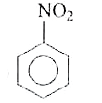Which of the following can give highest yield in Friedel craft reaction?




The correct Answer is:D
To determine which of the following can give the highest yield in a Friedel-Crafts reaction, we need to analyze the substituents on the benzene ring and their effects on the reaction. The Friedel-Crafts reaction can either be alkylation or acylation, and it requires an electrophile to react with the benzene ring.
1. Understanding Friedel-Crafts Reaction:
- The Friedel-Crafts reaction involves the introduction of an alkyl or acyl group into an aromatic ring using a Lewis acid catalyst, typically AlCl3. The reaction can be represented as:
Benzene+ElectrophileAlCl3−−−→Alkylated/Acylated Benzene
2. Identifying the Role of Substituents:
- Substituents on the benzene ring can either activate or deactivate the ring towards electrophilic substitution. Electron-donating groups (EDGs) activate the ring and increase the yield of the reaction, while electron-withdrawing groups (EWGs) deactivate it.
3. Evaluating the Given Options:
- Let's consider the substituents mentioned in the question:
- OH (Hydroxyl group): This group has a positive resonance effect (R effect) but also a negative inductive effect (I effect). However, it can form a complex with AlCl3, which can hinder the reaction.
- Cl (Chlorine): Chlorine has a positive resonance effect but a stronger negative inductive effect. It can also deactivate the ring but is less effective than OH in terms of resonance.
- NH2 (Amino group): This group has a strong positive resonance effect but can also form a complex with AlCl3, similar to OH, which can hinder the reaction.
- C-O-NH2 (Amide group): This group is more of an electron-withdrawing group due to the presence of the carbonyl, which would deactivate the ring significantly.
4. Conclusion:
- Among the options, the groups OH and NH2 would form complexes with AlCl3, thus inhibiting the Friedel-Crafts reaction. Chlorine, while it has a negative inductive effect, does not form such a complex and can still participate in the reaction, albeit less effectively than an electron-donating group. Therefore, the best option for achieving the highest yield in a Friedel-Crafts reaction would be Chlorobenzene.
Final Answer:
Chlorobenzene will give the highest yield in the Friedel-Crafts reaction.
- The Friedel-Crafts reaction involves the introduction of an alkyl or acyl group into an aromatic ring using a Lewis acid catalyst, typically AlCl3. The reaction can be represented as:
Benzene+ElectrophileAlCl3−−−→Alkylated/Acylated Benzene
- Substituents on the benzene ring can either activate or deactivate the ring towards electrophilic substitution. Electron-donating groups (EDGs) activate the ring and increase the yield of the reaction, while electron-withdrawing groups (EWGs) deactivate it.
- Let's consider the substituents mentioned in the question:
- OH (Hydroxyl group): This group has a positive resonance effect (R effect) but also a negative inductive effect (I effect). However, it can form a complex with AlCl3, which can hinder the reaction.
- Cl (Chlorine): Chlorine has a positive resonance effect but a stronger negative inductive effect. It can also deactivate the ring but is less effective than OH in terms of resonance.
- NH2 (Amino group): This group has a strong positive resonance effect but can also form a complex with AlCl3, similar to OH, which can hinder the reaction.
- C-O-NH2 (Amide group): This group is more of an electron-withdrawing group due to the presence of the carbonyl, which would deactivate the ring significantly.
- Among the options, the groups OH and NH2 would form complexes with AlCl3, thus inhibiting the Friedel-Crafts reaction. Chlorine, while it has a negative inductive effect, does not form such a complex and can still participate in the reaction, albeit less effectively than an electron-donating group. Therefore, the best option for achieving the highest yield in a Friedel-Crafts reaction would be Chlorobenzene.
Chlorobenzene will give the highest yield in the Friedel-Crafts reaction.
Topper's Solved these Questions
Similar Questions
Knowledge Check
Which of the following compounds will not give Friedel-Crafts reaction ?
A B
B C
C Dall of these
Dall of these
Friedel - Crafts acylation
View SolutionFriedel - Crafts acylation
View SolutionFriedel - Crafts acylation
View SolutionWhich of the following has the highest tendency to give the reaction,
M+(g)aqueous−−−−→mediumM+(aq)+e−?
View SolutionGive one example each of the following name reactions:
Friedel-Craft's reaction
View SolutionWhich of the following is an examples of Friedel Crafts reaction ?
View SolutionWhich of the following is used as a solvent in the Friedel-Crafts
reaction :-
View Solution
